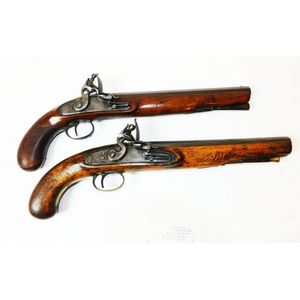Pair of 1820 London Flintlock Pistols
You must be a subscriber, and be logged in to view price and dealer details.
Subscribe Now to view actual auction price for this item
When you subscribe, you have the option of setting the currency in which to display prices to $Au, $US, $NZ or Stg.
- Bevel / Chamfer - In furniture making, a chamfered corner refers to a technique used to create a smooth, angled edge on the corner of a piece of furniture. This is typically done by cutting away a small portion of the corner at an angle, typically 45 degrees, creating a diagonal edge, rather than a sharp 90-degree angle. This technique can be used on various parts of a piece of furniture such as table legs, drawer fronts, or door frames. Chamfering can add visual interest to a piece and can help to soften the overall look of a piece of furniture. It is often used in conjunction with other techniques, such as rounding edges or using contrasting wood species to create a more elegant, sophisticated look. Chamfering is a simple way to add a touch of elegance to a piece of furniture and it is a common technique used by furniture makers.
- Circa - A Latin term meaning 'about', often used in the antique trade to give an approximate date for the piece, usually considered to be five years on either side of the circa year. Thus, circa 1900 means the piece was made about 1900, probably between 1895 and 1905. The expression is sometimes abbreviated to c.1900.
This item has been included into following indexes:
Visually similar items

Flintlock converted percussion pistol & another dated 1855 with a brass powder horn. Condition fair, some restoration . Length 43 cm

A pair of smaller than usual percussion holster Pistols converted from F/L made from old Belgian parts and unmarked furniture except for a crowned M, separate ram rods Cal. 60, barrel, length 16 cm

British fullstocked flintlock pistol by Hutchinson of Dublin of early 19th century date. Approx 425 mm overlal with 288 mm octagonal barrel of damascus twist of 16 bore. Steel mounted with engraved triggerguard, buttcap etc. The lock with gold lined waterp

Two World War I Souvenirs associated with Lieutenant Colonel Robert Rankine 14 Bn. A.I.F., including a Turkish brass belt buckle with white metal circle attached in relief Shownig a crescent moon surmounted by a five Pointed star with Arabic Script for 'Im
